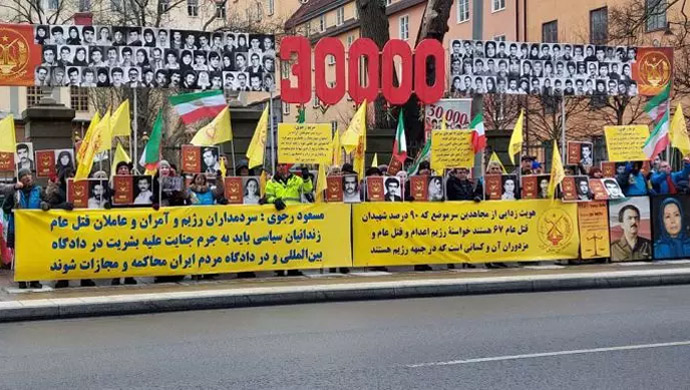After weeks of hearing the testimonies of witnesses and plaintiffs, the Swedish court that has been trying Hamid Noury, a regime official that has been involved in crimes against humanity, gave the defendant the chance to explain his side of the story.
Noury had four days to defend his case. But in four days, his attempts to vindicate himself only highlighted the scale of the atrocities committed in Iran’s prisons and the need to hold Iranian officials to account for their crimes.
In 1988, then-supreme leader Ruhollah Khomeini issued fatwa, a religious decree, ordering the purge of Iran’s prisons of all supporters of the People’s Mojahedin Organization of Iran (PMOI/MEK). Following Khomeini’s orders, more than 30,000 political prisoners were executed across Iran. In charge of carrying out the murderous deed were the Death Commissions, delegations of judicial and executive authorities who summoned prisoners and sealed their fate in minutes-long trials. All prisoners who refused to disavow their support for the MEK were immediately send to the gallows.
At the time, Noury was a torturer and senior prison guard in Gohardasht prison, Karaj. Therefore, his trial was focused on but a small part of the 1988 massacre, but one that was representative of the heinous crimes the regime committed in the past four decades.
Witnesses who testified in the court gave horrific accounts of torture, beatings, and mass hangings in Gohardasht prison. They described how Noury read prisoners’ names, took them to the Death Commission for trials, and then took them to the Death Hall, where they were hanged in groups. One prisoner who came back alive from the Death Hall even testified that Noury himself, along with all other staff in the prison, took part in the executions and pulled the chairs from under the feet of the prisoners. Other prisoners gave accounts of Noury and other prison officials beating and intimidating prisoners, and threatening to kill the few who survived the 1988 massacre.
When it finally became Noury’s turn to testify, he mostly veered into off-topic discussions and had to be reminded by the judge to stay within the context of the case. Noury resorted to lies and profanity against the MEK, rehashing the propaganda that Iranian state media and the regime’s foreign agents have been disseminating for decades. Albeit contradictory, his remarks were nonetheless important, revealing the fear that the regime has from the main opposition movement.
On the one hand, Noury claimed that the MEK is hated and unsupported inside Iran. But on the other, he referred to the MEK as monafeghin, a derogatory term the regime uses for the opposition. When the judge instructed him to avoid using profane terms, Noury replied that if he uses the term “Mojahedin,” he will be prosecuted when he returns to Iran. How can the regime be so sensitive to a “fringe group,” to the point that it will even prosecute its own loyal followers for mentioning their name?
Noury’s main defense was based on categorically denying the 1988 massacre, calling it a made-up story. He also denied the existence of Gohardasht prison and claimed that he was on leave during the 1988 massacre period.
He also denied that Khomeini had issued the fatwa to execute all MEK prisoners. And like other regime officials, he denied the existence of political prisoners in Iran’s jails.
Crime against humanity can’t be denied
These lies are so outrageous that even the regime’s own officials have not made such claims. During the 33 years that followed the 1988 massacre, the Iranian Resistance has gathered so many documents that this crime against humanity can’t be denied:
- Hundreds of testimonies by survivors of the 1988 massacre and families of the victims have been delivered to international human rights organizations.
- The MEK’s network inside Iran has documented dozens of mass graves where the regime secretly buried the bodies of the executed prisoners.
The regime’s own officials have also acknowledged the mass execution of political prisoners:
- In 1988, months after the massacre, regime authorities summoned the families of the executed prisoners and informed them of the death of their loved ones, though they refrained from telling them where the victims were buried.
- In recent years, some regime officials have explicitly acknowledged their role in the mass executions. In 2020, Mostafa Pourmohammadi, one of the members of the Death Commission and justice minister under regime president Hassan Rouhani, boasted about his role in the 1988 massacre.
- An audiotape of Hossein Ali Montazeri, Khomeini’s heir-apparent in 1988, explicitly referred to the mass executions as a great crime.
Noury’s testimony is further proof that the regime has been given free pass for its crimes for too long. It is worth noting that Noury’s trial is just the beginning of the justice that must be served. All the perpetrators of the 1988 massacre, including regime supreme leader Ali Khamenei and president Ebrahim Raisi, must one day be tried for their crimes against humanity.





